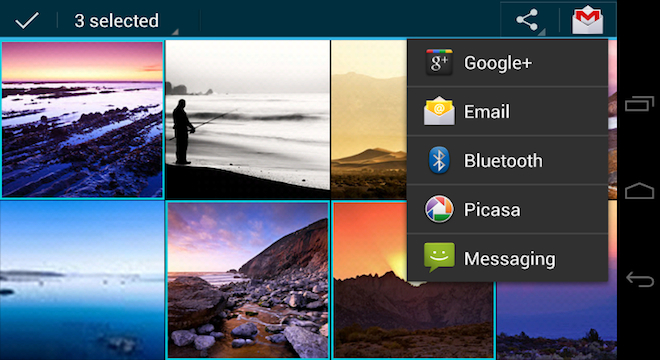It seems like ages since we first heard about Android 4.0, Ice Cream Sandwich, the latest confection-themed mobile operating system from Google. The company first announced Ice Cream Sandwich in May, and for the past five months, Android users and tech bloggers have been salivating over every micro-leak of information about the OS, which is designed to unify the previously disparate smartphone version of Android 2.3, Gingerbread, and the tablet version 3.0-3.2, Honeycomb.
But now, finally, the wait is over: Ice Cream Sandwich was officially unwrapped on Tuesday night in front of an audience in Hong Kong, along with the first smartphone to run it, the new Samsung Galaxy Nexus.
The new device and operating system were shown-off by Samsung President J.K. Shin and Google’s head of Android development, Andy Rubin. Watch the full video of the demo here (Warning: nearly an hour long.)
So far, the early reviews of the device and OS are almost uniformly positive. “From its navigation methods to fonts, Android is redesigned and refreshed in its Ice Cream Sandwich edition to meet the tastes of its users,” noted PC World‘s Armando Rodriguez “There’s simply a ton in here, and it’s almost certainly Android’s most significant upgrade to date,” wrote Gizmodo’s Brent Rose. As CNET‘s Jessica Dolcourt wrote: “There’s no mistaking that the Galaxy Nexus has all the ingredients it needs to be a terrific phone. There’s also no mistaking that its hands-down best feature, and the one that’s surest to wrest sales away from the Motorola Droid Razr, is the presence of Android 4.0 Ice Cream Sandwich,”
Perhaps the only person who didn’t have nice things to say about Android was the competition. At the Web 2.0 summit in San Francisco, Microsoft CEO Steve Ballmer said that Android was an operating system for “computer scientists,” InfoWeek reported.
“With Ice Cream Sandwich, our mission was to build a mobile OS that works on both phones and tablets, and to make the power of Android enticing and intuitive,” Rubin wrote in a post on the Google Mobile Blog. “We created a new font that’s optimized for HD displays and eliminated all hardware buttons in favor of adaptable software buttons. We also dramatically improved the keyboard, made notifications more interactive and created resizable widgets.”
The blog also includes a video trailer highlighting some of the features of the new Samsung Galaxy Nexus, including “Face Unlock,” which uses the phone’s front-facing videoconferencing camera to scan the user’s face, then employing “state-of-the-art facial recognition technology” to ensure that the face is the one of the device owner before unlocking the phone for use.
Other features of Ice Cream Sandwich update include:
Onscreen navigational buttons for “Back, Home and Recent Apps,” (compared to previous versions of Android used the respective device’s physical buttons)
A new multitasking interface . As Android’s developer page explains: “The Recent Apps button lets users jump instantly from one task to another using the list in the System Bar. The list pops up to show thumbnail images of apps used recently — tapping a thumbnail switches to the app.”
A new phone call text message intercept feature, that allows users in quiet situations the ability to intercept a phone call and respond to the caller via text, immediately silencing it.
Numerous new camera capabilities, including more camera zoom, focus and shutter settings, built-in face detection and a single-motion panorama mode, allowing the user to make one swipe with the camera and capture a wide angle photo. There’s a new built-in photo editor tool that allows users to apply all the effects and tweaks of a lite full desktop photo editor, live video effects (funhouse mirror style, and one that puts an Android backdrop behind the user) and finally, the long overdue ability to snap screenshots using just two buttons (previously Android users had to go as far as hooking their devices up to a computer to snap screenshots).
A refreshed Android web browser. No, it’s not the sought-after Google Chrome browser for desktop rendered mobile, but Android’s refreshed Webkit browser does now offer automatic synching with desktop Chrome’s bookmarks. Users can also save (read: download) webpages for offline viewing. Oh, and the page rendering performance has been boosted by 220 percent over Gingerbread, according to the developer’s blog.
The new Android also offers a new “explore-by-touch mode” specifically designed to let visually impaired users enjoy the full features of their device without using the screen, using audio feedback. Idea Lab earlier reported on the development of a similar app for tablets developed at Stanford.
A new, built-in near-field communications sharing mode, “Android Beam,” that allows Android Ice Cream Sandwich users to wirelessly exchange most data -apps, music, videos and contacts- by simply touching phones. Yes, iPhone lovers will recognize this as an Anrdoid version of “Bump,” a popular iOS app that’s been around for years.
There’s a host of other, more cosmetic and minor updates as well, including improved email, expanded WiFi and Bluetooth connectivity support and a “unified” calendar and visual voicemail. Check out the full list at the Android Developers page, where developers can also download the new Ice Cream Sandwich software development kit (SDK).
Buyers will have to wait a little while longer before they can sink their teeth into the new operating system. The Galaxy Nexus won’t be available until sometime in November, where it will go on sale in the United States, Canada, Europe and Asia. Pricing isn’t official from Samsung, but one U.K. merchant, Clove, has priced the 16 GB version at 429 pounds sterling (about $679 U.S.). Carrier information also hasn’t been confirmed, although based on a leaked screenshot on the Verizon U.S. website, it appears that it will be at least the initial carrier of the device in the U.S.
As for current Android users not necessarily seeking to buy a new device but still craving a new operating system experience, the jury is still out on when the update will be available for download. PC World notes that Google says that Ice Cream Sandwich should work fine on any device running Android 2.3 Gingerbread, which includes:
HTC’s Desire, Desire Z, Desire HD, Droid Incredible, Droid Incredible 2, Evo 4G, Incredible S, and ThunderBolt; LG’s Optimus 2X and Optimus One; Motorola’s Atrix 4G, Droid 2, Droid Pro, and Droid X; Google’s Nexus One and Nexus S; Samsung’s Galaxy S; Sony’s Xperia X10; and T-Mobile’s G2 and myTouch 4G.
However, HTC users may be in a bit of a jam, as the Taiwanese-based company issued a tentative press release saying it would hold off on any immediate upgrades, due to the fact that its custom HTC Sense user interface is so tightly intertwined with the older versions of Android.









